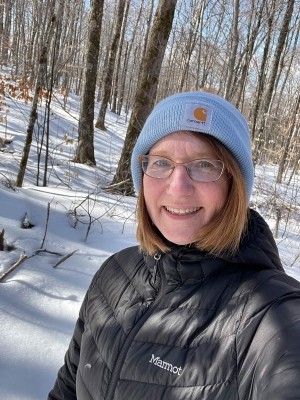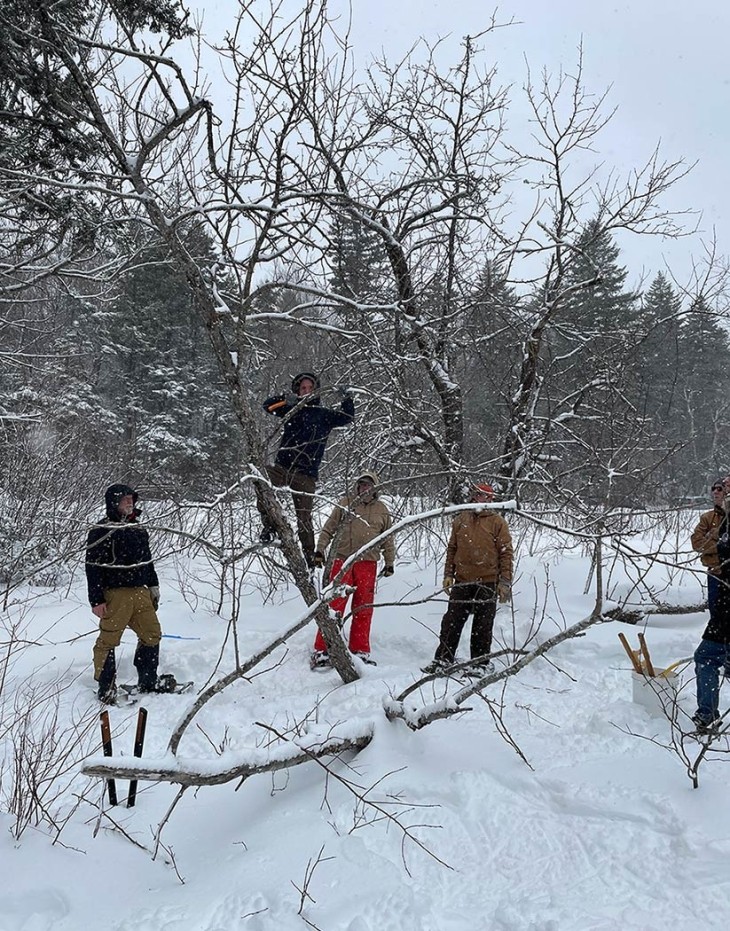Growing up in Stamford, Connecticut, Lisa Sausville reveled in trips to her family’s retreat near a working dairy farm once owned by her great-grandparents in a rural part of the state. There, she would “adventure into the trees and the woods and the barn.” A lifelong lover of animals, she earned an Environmental Studies degree from University of Vermont, then a master’s in Wildlife Management from South Dakota State University. Since 2006 she has been the executive director of Vermont Coverts, where she helps landowners gain knowledge and tools for managing their forestland and stewarding wildlife habitat – and share that knowledge with their communities.
I loved animals as a child, and I always said I wanted to do something with animals, but I was not interested in being a veterinarian. I didn’t want to work with domestic animals. I was a science nerd. So, I applied to Animal Science at UVM. I had no idea “animal science” was dairy science. Instead, my path led me to be an environmental studies major with a wildlife biology minor.
I thought I wanted to go into environmental law. That changed after I did internships with the National Wildlife Federation and Vermont Natural Resources Council just out of college. I worked with a lawyer and with a lobbyist, and it just felt like it was banging your head against a brick wall to make small differences. Although this is important work, I wanted to be more on the wildlife management side, being outdoors and working with animals and people.
Then I worked at Missisquoi National Wildlife Refuge, and I just loved being there. In this field, when you start out, you end up working short-term – 3-months, 6-months, a year. You get one job, and you’re already looking for the next job in wildlife, because so much of these beginning jobs is getting experience in doing all of the different things and deciding where you want to go. At Missisquoi, I was hired to treat invasive purple loosestrife, which takes over the native wetland habitat. I also was involved with checking wood duck boxes for production, helping do some of the waterfowl banding, but also maintenance and signage and all those other aspects that are involved when you manage a wildlife area. It was an interesting experience.
I eventually went to grad school in South Dakota, then worked in Pennsylvania and in Virginia. But I loved New England, and Vermont. My husband and I always wanted to come back here. We met at UVM. He’s also a wildlife biologist. He found a job here when our children were young, and I really wanted the opportunity to stay home with them. I was looking for the next opportunity when the Coverts position became available in 2006. It was part-time then and offered the perfect opportunity to get back in the field.
I consider myself a gregarious person. I enjoy talking with people. I say that if I can’t be working with animals, I like being with people. That’s sort of the Coverts avenue – working with people, educating them about sound forest stewardship and wildlife management. It seemed like a nice fit, and it’s grown over time into the opportunity to continue that influence in a variety of ways.
The full name of the organization is Vermont Coverts: Woodlands for Wildlife. My elevator speech is that it’s an organization that educates landowners and others about sound forest management and wildlife stewardship. It was started out of Extension in Vermont and Connecticut by the Extension foresters, Tom McAvoy and Steve Broderick. They had their first Coverts Cooperator training in 1985. The name is a portmanteau: Connecticut plus Vermont is part of the history of the name, but “coverts” [pronounced “cuh-verts,” not “coe-verts”] is also an old English word for cover or thicket or a place where wildlife likes to hide.
Coverts is a peer-to-peer network. The 3-day Cooperator Training is our flagship program. We offer it two times a year. It basically focuses on bringing people through the history of wildlife in the state, and helping them understand how forests work, forest ecology, wildlife management and what’s involved in managing habitats, what kind of habitat different wildlife needs and why we need a diversity of habitats – not just old forests or just new forests. Then it moves into how to influence and manage the woods in specific areas. We also go through what the threats to the forests are and how we address those. And people share this through our peer-to-peer network in a variety of ways, whether it’s being active on their own land or talking with their neighbors or hosting a workshop or writing an article. We also now have stewardship workshops that we coordinate or we work with our landowners to coordinate so they’re sharing their interests and passions.
We’re also working on passing lands programs, and we host Passing Lands Pop-ups – I call them speed dating with professionals. Landowners can meet with a lawyer, a land trust person, a landowner who has conserved their land, a forester, a financial planner. These are all people that you need to work with when you think about passing your land to the next generation. This pop-up gives them the chance to understand what each of these people do and to ask them questions. It starts them thinking about who they need to see next, what are the steps they need to take. It’s a great insight, and it’s been very well received. There are a lot of different options and solutions. It could be a conservation easement. It could be giving land to an agency or a nonprofit. It could be giving it to someone who is an heir who isn’t related to you – a neighbor or a friend who you trust. So, this program helps people look at what some of those options might be that will benefit them personally, financially.
Working with different landowners is definitely my favorite part of this work. I often work alone prepping and preparing an event, so I get my energy from the two weekends of Cooperator Training, just being with them. It’s really satisfying to develop these close relationships of support and friendship. One of my favorite taglines is that we like to connect people to their land, wildlife, and each other. That’s really the beauty of it. It’s not just, “Come and learn about something and come to our workshop.” It’s, “Come and meet other people who think and love the land the way you do and let’s enjoy each other’s company together.”
I really love the chance to create opportunities for these landowners to connect, to learn, and to activate. We call it the journey of the landowner moving them from wherever they are on that continuum of interest, to knowledge, to action. When they say they did something because they went through the Coverts training – they got a forest management plan, or started doing things on their land, or got involved in their community, or conserved their land, or joined their conservation commission I know we are making a difference. That’s all being a Coverts Cooperator. We want to empower them to be active on their land and in their communities.
When you ask a landowner to speak about their land, they often get emotional. Knowing that people feel that way and that we can help them have the skills to continue to have that special place is really valuable. I can list dozens of landowners who have told me that this experience – the Cooperator Training – has changed their life. That’s amazing to me.
There’s a lot of pressure on forests now. When you have one invasive, the forest or the tree can probably handle that, but then another one comes in, and a third one comes in. It’s the compounding impacts on our forest – climate change and invasives and development pressure – that concern me. How do we continue to address all of those? And the answer is through education and connection, getting people interested and active. It’s all about choices, and that’s one of the things we tell our landowners. You may choose to pull invasives, or you may choose to use herbicides. Here are the options. Here are the tools in the toolbox. You are the landowner, you can decide what works for you by knowing the strategies. It’s really about providing the knowledge and the resources to make informed decisions.
During the pandemic, we started the Coverts Book Group. We started with reading A Sand County Almanac like an almanac. So, we read January, February, and March and talked about those months. Each month, we were reading the month that we were in and discussing that and reading other essays in the book. That was amazing. It’s a hard book to sit down and read cover to cover and reading it this way was powerful. We started that in 2021, and we have continued. We call it a slow read, because a lot of the books are dense. They’re nonfiction. The second year we read Finding the Mother Tree, Entangled Life, and The Trees in My Forest. We read one book over four months. We read half the book and discuss it, then read the other half and discuss that. And every year we take one field trip that we try to relate to the books we’ve read. So in 2023 we read Nature’s Best Hope, Eager, and Accidental Ecosystems. Then, relating to our read of Eager, we met with Tyler Brown from Vermont Fish and Wildlife. We visited a beaver baffle and talked about wetlands and beaver management. This year we’re starting off with Crossings, and we’ll be reading These Trees Tell a Story and Gathering Moss. We meet by Zoom, and we have some people who can no longer get out on the land, and this is the way that they’re connecting and sharing.
I like to explore new places. Every place I’ve lived, I’ve just loved and tried to delve into and understand the diversity of that place. I was a non-game and endangered species biologist in Virginia, which is a fascinating state. You went east to west, from the ocean to the mountains through the Piedmont. And when you went north to south, you were at the southern range of the northern species because of the mountains, and at the northern range of the southern species because of the Piedmont and the shore. We lived in South Dakota, where you had the prairies on the eastern side, and the Badlands on the west side.
Vermont is so unique. You’ve got the Northeast Kingdom, southern Vermont, patches of old growth forest, Snake Mountain here in Addison is a wonderful place to hike. I like finding new places to explore and experience. I enjoy birding, hiking, camping, ice fishing, skiing and also reading, knitting and scrapbooking. I think being in the outdoors is special. It’s a place to feel energy, peace, resilience. We have some amazing places in Vermont, whether it’s state parks, wildlife management areas, the Marsh-Billings-Rockefeller National Historic Park, Missisquoi National Wildlife Refuge, Conte Wildlife Refuge – there are so many amazing places to experience the outdoors here in Vermont. We’re lucky, and I’m grateful for what people in the past have done here – and hopeful that people in the future will continue that caring sentiment and that land ethic to really be concerned and thoughtful about how we manage and conserve our woodlands.





Discussion *